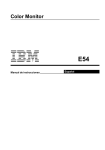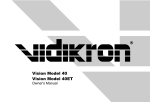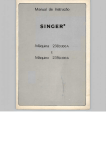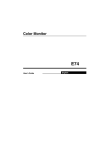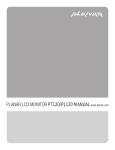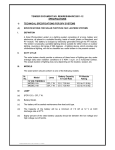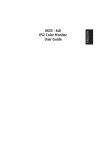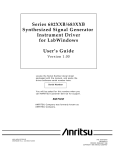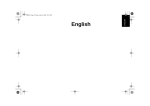Download IBM E54 User's Manual
Transcript
Color Monitor E54 Operating Instructions English IBM E54 Color Monitor Users Guide 6331-07N 6331-97N 6331-47N 6331-67N Edition 1 This publication could contain technical inaccuracies or typographical errors. Changes are made periodically to the information herein; these changes will be made in later editions. IBM may make improvements and/or changes in the product(s) and/or program(s) at any time. It is possible that this publication may contain reference to, or information about, IBM products (machines and programs), programming, or services that are not announced in your country. Requests for copies of this publication and for technical information about IBM products should be made to your IBM Authorized Dealer or IBM Retailer. No part of this publication may be reproduced or distributed in any form or by any means without prior permission in writing from the International Business Machines Corporation. References in this publication to IBM products, programs, or services do not imply that IBM intends to make these available in all countries in which IBM operates. Any reference to an IBM product, program or service is not intended to state or imply that only IBM's product, program, or service may be used. Any functionally equivalent product, program, or service that does not infringe any of IBM's intellectual property rights or other legally protectable rights may be used instead of the IBM product, program, or service. Evaluation and verification of operation in conjunction with other products, programs, or services, except those expressly designated by IBM, are the user's responsibility. IBM may have patents or pending patent applications covering subject matter in this document. The furnishing of this document does not give you any license to these patents. Trademarks The following terms, used in this publication, are trademarks or service marks of the IBM Corporation in the United States or other countries: IBM • • • • • HelpCenter ENERGY STAR® is a U.S. registered mark. DDC™ is a trademark of the Video Electronics Standard Association. VESA is a trademark of Video Electronics Standard Association. All other product names mentioned herein may be the trademarks or registered trademarks of their respective companies. Furthermore, “™” and “®” are not mentioned in each cases in this manual. © Copyright International Business Machines Corporation 2001. All rights reserved. International Business Machines Corporation New Orchard Road, Armonk, NY 10504 Note to U.S. Governmemt Users--Documentation related to restricted rights--Use, duplication, or disclosure is subject to restrictions set forth in GSA ADP Schedule Contract with IBM Corp. Table of Contents Precautions ............................................................... US-1 Installation .......................................................................................... US-1 Maintenance ....................................................................................... US-1 Transportation .................................................................................... US-1 Use of the Tilt-Swivel .......................................................................... US-1 Power Connection Information ........................................................... US-1 Identifying Parts and Controls ................................ US-2 Unpacking Procedure .............................................. US-3 Repacking ................................................................. US-3 Setup ......................................................................... US-3 Step 1: Install the monitor .................................................................. US-3 Step 2: Connect your monitor to your computer ................................ US-3 Step 3: Connect the power cord ........................................................ US-4 Step 4: Turn on the monitor and computer ........................................ US-4 Workplace Preparation ....................................................................... US-4 Using the On-Screen Menu ...................................... US-5 Individal Adjustment ................................................ US-6 Technical Features ................................................... US-8 Preset modes ..................................................................................... US-8 Note for Windows users ..................................................................... US-8 Power saving function ........................................................................ US-8 Troubleshooting ....................................................... US-8 Self-Diagnosis Function .......................................... US-9 Specifications ........................................................... US-9 Service Information ................................................ US-11 US-1 PRECAUTIONS Installation Do not install the monitor in the following places: • on surface (rugs, blankets, etc.) or near materials (curtains, draperies, etc.) that may block the ventilation holes. • near heat sources such as radiators or air ducts, or in a place subject to direct sunlight. • in a place subject to severe temperature changes. • in a place subject to mechanical vibration or shock • on an unstable surface. • near equipment which generates magnetism, such as a transformer or high voltage power lines. • near or on a magnetically charged metal surface. • in a small space around the top, bottom and sides of the monitor that may block the ventilation holes. Use of the Tilt-Swivel This monitor can be adjusted within the angles shown below. Hold the monitor at the bottom with both hands when you turn it horizontally or vertically. Be careful not to pinch your fingers at the back of the monitor when you tilt the monitor up vertically. Maintenance • • • Clean the cabinet, panel and controls with a soft cloth lightly moistened with a mild detergent solution. Do not use any type of abrasive pad, scouring powder, or solvent, such as alcohol or benzine. Do not rub, touch, or tap the surface of the screen with sharp or abrasive items such as a ballpoint pen or screwdriver. This type of contact may result in a scratched picture tube. Clean the screen with a soft cloth. If you use a glass cleaning liquid, do not use any type of cleaner containing an anti-static solution or similar additive as this may scratch the screen’s coating. Transportation Note Do not remove the tilt-swivel base from the monitor. Power Connection Information • Use an appropriate power cord for your local power supply. • Before disconnecting the power cord, wait at least 30 seconds after turning off the power to allow the static electricity on the CRT display surface to discharge. After the power has been turned on, the CRT is demagnetized (degaussed) for a few seconds. This generates a strong magnetic field around the metal frame, which may affect the data stored on magnetic tapes and disks near the bezel. Place magnetic recording equipment, tapes, and disks away from this monitor. When you transport this monitor for repair or shipment, use the original carton and packing materials. • The equipment should be installed near an easily accessible electrical outlet. US-2 IDENTIFYING PARTS AND CONTROLS Rear See the pages in parentheses for further detail. Front g f f. AC input connector This connector provides AC power to the monitor. Video input cable Inputs RGB video signals (0.700 Vp-p, positive) and sync signals. 1 5 g. a b c d e a. b. Displays menu & exits menu Scrolls through menu to choose an icon for adjustment / Adjusts level of selected icon c. Confirms menu selection d. Power ON/OFF switch e. Power LED 15 Pin Function Pin Function 1 Red signal 9 +5V (from computer) 2 Green signal 10 Digital ground 3 Blue signal 11 Ground 4 Ground 12 SDA (DDC1/DDC2B) 5 NC (*NOTE) 13 Horizontal Synchronization 6 Red return 14 Vertical synchronization & VCLK (DDC1) 7 Green return 15 SCL (DDC 2B) 8 Blue return *NOTE: This pin is used for self test detection; at side, this pin has to be connected to ground. MONITOR US-3 UNPACKING PROCEDURE À Á SETUP This monitor works with platforms running at horizontal frequencies between 30 and 69 kHz. Step 1: Install the monitor • Â Ã • To connect the tilt/swivel base to the monitor, align hooks with the sockets on bottom side of the monitor, and gently push the base towards the front of the monitor. Put monitor on a flat and stable working bench. Ä REPACKING Save the original box and all packing material for future shipping needs. Step 2: Connect your monitor to your computer • • Turn off the monitor and computer before connecting. Connect the video signal cable to the video output of your computer The 15-pin D-shell signal connector on the signal cable will connect easily to the video adapter output on your personal computer. Tighten both screws on the connector to ensure a firm connection. Note • Do not touch the pins of the video signal cable connector as this might bend the pins. • When connecting the video signal cable, check the alignment of the video input connector. Do not force the video input connector in the wrong way or the pins might bend. US-4 Step 3: Connect the power cord Workplace Preparation With the monitor and computer turned off, first connect the proper power cord for your local supply to the monitor, then connect it to a properly grounded power outlet. Positioning the Monitor Choose a suitable place to position the monitor where it is not near fluorescent desk lighting or any equipment that produces magnetic field that could cause interference. Ensure that the furniture or equipment can support the weight of the monitor. Allow at least 2 inches (50 mm) ventilation space around the monitor. Height The monitor should be positioned so that the top of the screen is slightly below your eye level when you sit at your workstation. Step 4: Turn on the monitor and computer • • • Turn the monitor power switch ON. Then turn the MONITOR power switch ON, by pressing the switch inward. The green power indicator will light up. Allow about 30 seconds for the CRT tube to warm up. Data will be displayed on the screen. If your display fails to function properly, please first refer to the section "Troubleshooting" in this manual. Orientation Choose a position that gives the least reflection from lights and windows, usually at a right angle to any windows. The monitor should be positioned directly in front of you so that you do not have to twist your body. Tilt the monitor to a comfortable viewing angle. Working Practices Rest Take regular breaks. Vary your posture, and stand up and stretch occasionally as prolonged use of computer workstations can be tiring. Back You should sit back in the chair and use the backrest. Hands Use a light touch on the keyboard, keeping your hands and fingers relaxed. Allow a space in front of the keyboard to rest your wrists when not typing. Consider using a wristpad. Eyesight Working with monitor, in common with any kind of prolonged close work, can be visually demanding. Look away from the screen periodically and have your eyesight checked regularly. Screen settings Set the screen brightness and contrast to a comfortable level. You may have to adjust this as the lighting changes during the day. Many application programs let you select color combinations which can help you to view in comfort. US-5 USING THE ON-SCREEN MENU 1) Menu screen-press the 1 button to display the menu below and exit menus Select mark Press the button to move the selection mark to the desired location. Adjustment icons 1: CO NTRAST The item presently being adjusted is shown. :2 When the 2 button is pressed. The selected adjustment screen appears. CONTRAST BRIGHTNESS H. SIZE H. POSITION V. SIZE V. POSITION PINCUSHION TRAPEZOID ROTATION COLOR LANGUAGE DISP. FREQ. DEGAUSS RECALL H. MOIRE V. MOIRE 1: CONTRAST :2 2) Adjustment screen (example: horizontal position adjustment) Name of adjustment screen Adjustment icon End Button When the 1 button is pressed, the adjustment level is stored, the adjustment screen is ended and the menu screen returns. The adjustment level is shown by both a number and a bar. It can be varied with the front buttons. When the 2 button is pressed, the horizontal size adjustment screen appears. On the adjustment screen where these two adjustment icons appear, it is possible to switch between the two screens by pressing the 2 button. NOTE: The amount of adjustment depends upon how long you depress the adjustment button. You may have to tap the button to obtain the desired results. US-6 INDIVIDUAL ADJUSTMENT CONTRAST adjustment Adjust the screen contrast to match your personal preference. Press the button to decrease contrast and press the button to increase it. Direct operation: You can access the CONTRAST adjustment screen by pressing the or before entering the menu screen. Press the 2 key toggles between CONTRAST and BRIGHTNESS. BRIGHTNESS adjustment VERTICAL SIZE adjustment Fills the viewable area vertically. Press the button to make the image smaller, or press the button to make it larger. Press the 2 key toggles between VERTICAL SIZE and VERTICAL POSITION. VERTICAL POSITION adjustment Shifts the image on the screen vertically. Press the button to move it downward, or press the button to move it upward. Press the 2 key toggles between VERTICAL SIZE and VERTICAL POSITION PINCUSHION adjustment Adjusts the brightness to get the desired background level. Press the button to make the background lighter, the button to make it darker. Press the 2 key toggles between CONTRAST and BRIGHTNESS. The image can be corrected for barrel distortion. Press the button or the button to eliminate curved vertical lines. Press the 2 key toggles between PINCUSHION and TRAPEZOID correction. HORIZONTAL SIZE adjustment TRAPEZOID adjustment Fills the viewable area horizontally. Press the button to make the image narrower, or press the button to make it wider. Press the 2 key toggles between HORIZONTAL SIZE and HORIZONTAL POSITION. The image can be corrected for the trapezoidal distortion. Press the button to narrow the top edge, or press the button to make the top edge wider. Press the 2 key toggles between PINCUSHION and TRAPEZOID correction. HORIZONTAL POSITION adjustment Shifts the image on the screen horizontally. Press the button to move the screen image to the left, or press the button to move it to the right. 2 Press the key toggles between HORIZONTAL SIZE and HORIZONTAL POSITION. ROTATION adjustment The image can be corrected for tilted picture. Press the button to tilt the image to the left, or press the button to tilt the image to the right. US-7 COLOR selection The white of the image can be adjusted. 1) Use the button to select: (1)9300 OK, (2)6500O K or (3)User color. 2) If the (3):the user’s color is selected, “2” appears in the lower right of the On-Screen Menu. Press the 2 button to display the USER COLOR adjustment screen. USER COLOR The white of the video image can be adjusted to the user’s preferred color. 1) Use the 2 button to select R (red), G (green) or B (blue). 2) Use the button to adjust the color as desired. IMPORTANT-Memory recall of the user’s color is not possible, so take note of the initial setting before adjusting. When the monitor is turned OFF, user color keeps the last adjustment. LANGUAGE selection The language of the On-Screen Menu can be selected among English, French, German, Italian and Spanish. Select with the buttons. DISP. FREQ (Input frequency display) This displays the input synchronization signal frequency. It identifies the horizontal and vertical frequency sent to the monitor from the video card currently in use. MANUAL DEGAUSSING After moving the selector to the degauss icon, press the 2 button. The degaussing action takes place a few seconds later. Note: A sharp snap noise may be heard when degaussing occurs. This is normal. MEMORY RECALL It is possible to restore adjustments to the original factory settings. If the monitor is operating in a user defined mode, this control has no effect. HORIZONTAL MOIRE Reduce the dark wavy line Moire pattern on the screen. Press the or button to minimize the horizontal moire image on the screen. VERTICAL MOIRE Reduce the dark wavy line Moire pattern on the screen. Press the or button to minimize the vertical moire image on the screen. US-8 TECHNICAL FEATURES TROUBLESHOOTING Preset modes Before contacting technical support, refer to this section. Mode Resolution (H x V) V. Freq. (Hz) 1 640 x 480 60 (VESA) 2 640 x 480 75 (VESA) 3 640 x 480 85 (VESA) 4 720 x 400 70 (Ind. Standard) 5 800 x 600 60 (VESA) 6 800 x 600 75 (VESA) 7 800 x 600 85 (VESA) 8 1024 x 768 60 (VESA) 9 1024 x 768 75 (VESA) 10 1024 x 768 85 (VESA) Note for Windows users For Windows users, check your graphics board manual or the utility program which comes with graphics board and select the highest available refresh rate to maximize monitor performance. Power Saving Function The monitor will be driven into “Power Saving” mode by the control signal from the display controller, as indicated by the amber-color power LED. State Power Consumption LED Light ON Normal Green Active OFF < 5W Amber The power saving states will be kept until a control signal has been detected or the keyboard or mouse is activated. The recovery time from Active OFF state back to ON state is around 10 seconds. Problem Blank screen Check & Adjust · · · Monitor power switch, power cord, signal cable, or connector Computer power switch Brightness & contrast controls Display position off-center · Vertical centering & horizontal phase controls Display too small or too large · Vertical & horizontal size controls Display too bright or too dim · Brightness & contrast controls Refer to the operation instructions of your computer/ video adapter to ensure that you have the correct signal output source for the monitor. Ensure that the switches on the video adapter are set correctly for operation with this monitor. If the above steps fail to correct the problem contact your dealer for servicing by qualified service personnel. US-9 SELF-DIAGNOSIS FUNCTION This monitor is equipped with a self-diagnosis function. You can easily distinguish if the problem is on the monitor or on the computer by using the monitor’s built-in selftest function. With the monitor power ON, disconnect the signal cable from computer. If you see a “NO SIGNAL” image on the screen, the monitor is functioning properly, and the problem is with the MONITOR side or signal cable. SPECIFICATIONS S cre e n S ize 15 in. visual diagonal Viewa ble scr een size 13.7 5 in. Anti- Glar e, AntiReflective C oating* D ot Pi tch 0.28 mm d iagona l 0.24 mm horizo ntal D is pl ay Are a D e faul t Full S can (H x W) 262 x 1 96 mm (10. 31 x 7.7 2 in.) , typ ical 282 x 2 11 mm (11. 1 x 8.3 1 in.) , depends on signal timing D is pl ay Colors Infinite M ax. R e s olu tion 1280 Dot s x 1024 L ines Compati bili ty Graphic modes with horizont al fr equencies bet we en 30 K Hz to 69 K Hz S ynchronizat ion Horizontal: Ve rti cal: 30 t o 69 K Hz 50 t o 120Hz B andwid th 110 M Hz Input S ignal Vide o: RGB Analo g S ync. : TTL S ep arate S igna l Cable 15- pin D- sub connect or US-10 90 to 264 V AC 50 - 6 0 Hz Curre nt Rating 1. 5 A Po we r Co ns umption 75 W ( MAX. ) Dime ns io n (W x H x D) 37 0 x 387 x 3 90 mm (1 4.6 x 15. 2 x 15. 4 in.) We ight 12 kg Ope rat ing Te mpe rature 5°C to 40 °C (4 1°F to 104 °F) St ora ge Te mpe rature - 4 0°C to 65° C (- 40°F to 1 49° F) Humidity 20 % to 80 % (non- condensing) Altit ude Up to 100 00ft * Po we r Input Vo lta ge / Fre que nc y TCO version has a different surface treatment. US-11 SERVICE INFORMATION The following parts are for use by IBM services, or IBM authorized dealers, to support customer warranty. Parts are for service use only. Monitor Information PART NUMBER DESCRIPTION M/T MODEL COLOR 22P7922 E54 Monitor MPR-II, NH 6331 07N Pearl White 22P7923 E54 Monitor TCO-99, NH 6331 97N Pearl White 22P7924 E54 Monitor MPR-II, NH 6331 47N Stealth Black 22P7925 E54 Monitor TCO-95, NH 6331 67N Stealth Black 22P7926 E54 FRU - Tilt/Swivel --- --- Pearl White 22P7927 E54 FRU - Tilt/Swivel --- --- Stealth Black















